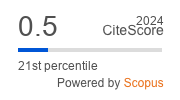Modern principles of management of patient safety (systematic review)
https://doi.org/10.47093/2218-7332_2018.3.17-24
Abstract
About the Author
Y. E. VoskanyanRussian Federation
References
1. O'Hagan J, Mac Kinnon N.J, Persaud D, Etchegary H. Self-Reported medical errors in seven countries: implications for Canada. Healthcare Quarterly 2009; 12 (Sp.): 55-61.
2. Brennan T.A, Leap L.L, Larid N.M et al. Incidence of adverse events and negligence in hospitalized patients: results of the Harvard Medical Practice Study I. N Engl J Med 1991; 324: 370-6.
3. Deilkås E.T, Bukholm G, Lindstrøm J.C, Haugen M. Monitoring adverse events in Norwegian hospitals from 2010 to 2013. BMJ Open 2015; 5: 1-6.
4. Zegers M, Bruijne M.C, Wagner C et al. Adverse events and potentially preventable deaths in Dutch hospitals: results of a retrospective patient record review study. Qual Saf Health Care 2009; 18: 297-302.
5. Makary M.A, Daniel M. Medical error - the third leading cause of death in the US. BMJ 2016; 353 (3): 1-5.
6. Leap L. Error in Medicine. JAMA 1994; 272 (23): 1851-7.
7. Beuzekom M, Boer F, Akerboom S, Hudson P. Patient safety: latent risk factors. Br J Anaesthes 2010; 105 (1): 52-9.
8. Lawton R, Carruthers S, Gardner P et al. Identifying the latent failures underpinning medication administration errors: an exploratory study. Health Services Res 2012; 47 (4): 1437-59.
9. El Bardissi A, Wiegmann D, Dearan J et al. Application of the human factors analysis and classification system methodology to the cardiovascular surgery operating room. Ann Thorac Surg 2007; 83: 1412-9.
10. Reason J. Human error: models and management. Br Med J 2000; 320: 768-70.
11. Hoffmann B, Rohe J. Patient safety and error management. Dtsch Arztebl Int 2010; 107 (6): 92-9.
12. Mitchell R, Williamson A, Molesworth B, Chung A. A review of the use of human factors classification frameworks that identify causal factors for adverse events in the hospital setting. Ergonomics 2014; 57 (10): 1443-72.
13. Carayon P, Schoofs Hundt A, Karsh B et al. Work system design for patient safety: the SEIPS model. Qual Saf Health Care 2006; 15 (Suppl. I): i50-i58.
14. Wadhera R, Parker S, Burkhart H et al. Is the “sterile cockpit” concept applicable to cardiovascular surgery critical intervals or critical events? The impact of protocol - driven communication during cardiopulmonary bypass. J Thorac Cardiovasc Surg 2010; 139 (2): 312-9.
15. Clancy C, Tornberg D. Team STEPPS: Assuring optimal team - work in clinical settings. Am J Med Qual 2007; 22 (3): 214-7.
16. Carthey J, de Leval M, Reason J. The human factor in cardiac surgery: errors and near misses in a high technology medical domain. Ann Thorac Surg 2001; 72: 300-5.
17. Edmondson A. Learning from failure in health care: frequent opportunities, pervasive barriers. Qual Saf Health Care 2004; 13 (Suppl. II): ii3-ii9.
18. Freed D, Drain J, Kitcat J et al. Death in low - risk cardiac surgery: the failure to achieve a satisfactory cardiac outcome (FI- ASCO) study. Interact Cardiovasc Thorac Surg 2009; 9: 623-5.
19. Farid S, Page A, Jenkins D et al. FIASCO II failure to achieve a satisfactory cardiac outcome study: the elimination of system errors. Interact Cardiovasc Thorac Surg 2013; 17: 116-9.
20. Lyons M. Should patients have a role in patient safety? A safety engineering view. Qual Saf Health Care 2007; 16 (2): 140-2.
21. Verstappen W, Gaal S, Esmail A, Wensing M. Patient safety improvement programmes for primary care. Review of a Delphi procedure and pilot studies by the LINNEAUS collaboration on patient safety in primary care. Eur J Gen Pract 2015; 21 (Suppl. 1): 50-5.
22. Molloy G.J, O'Boyle C.A. The SHEL model: a useful tool for analyzing and teaching the contribution of Human Factors to medical error. Acad Med 2005; 80 (2): 152-5.
23. Takayanagi K, Hagihara Y. Revised sunflower-SHELL model - an analysis tool to ensure adverse - events' factor analysis and followed by patient safety strategy. Jpn Hosp 2007; 25: 11-8.
24. Marsteller J, Wen M, Hsu Y et al. Safety culture in cardiac surgical teams: data from five programs and national surgical comparison. Ann Thorac Surg 2015; 100: 2182-9.
25. Sanchez J, Ferdinand F, Fann J. Patient safety science in cardiothoracic surgery: an overview. Ann Thorac Surg 2016; 101: 426-33.
26. Pronovost P, Weast B, Holzmueller C et al. Evaluation of the culture of safety: survey of clinicians and managers in an academic medical center. Qual Saf Health Care 2003; 12: 405-10.
27. Lilford R, Mohammed M, Braunholtz D, Hofer T. The measurement of active errors: methodological issues. Qual Saf Health Care 2003; 12 (Suppl. II): ii8-ii12.
28. Hibbert P, Williams H. The use of a global trigger tool to inform quality and safety in Australian general practice: a pilot study. Aust Fam Physician 2014; 43 (10): 723-6.
29. Michel Ph, Quenon J, de Sarasqueta A, Scemama O. Comparison of three methods for estimating rates of adverse events and rates of preventable adverse events in acute care hospitals. BMJ 2004; 328 (24): 199-202.
30. Pietra L, Calligaris L, Molendini L et al. Medical errors and clinical risk management: state of the art. Act Otorhinolaryng Ital 2005; 25: 339-46.
31. Shaw R, Drever F, Hughes H et al. Adverse events and nearmiss reporting in the NHS. Qual Saf Health Care 2005; 14: 279-83.






































